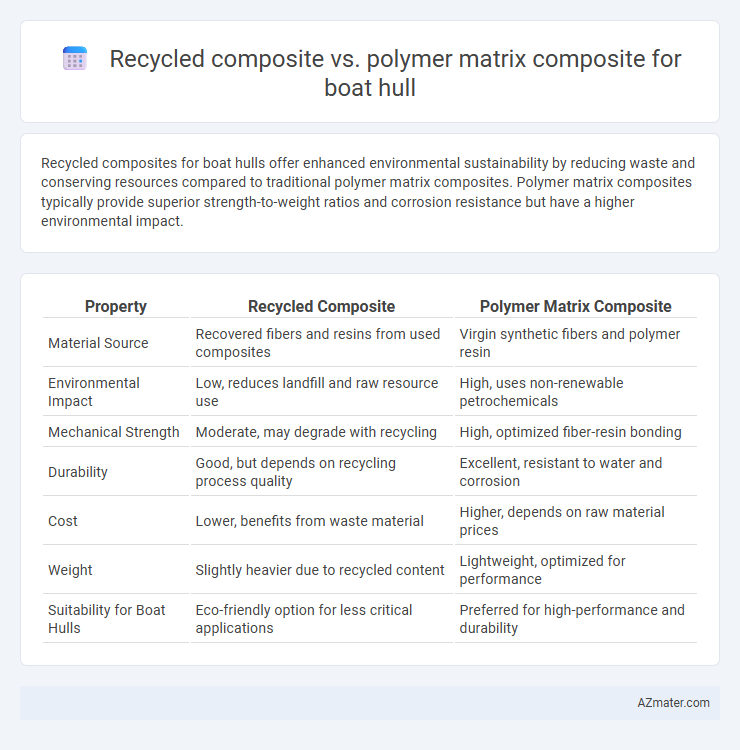Recycled composites for boat hulls offer enhanced environmental sustainability by reducing waste and conserving resources compared to traditional polymer matrix composites. Polymer matrix composites typically provide superior strength-to-weight ratios and corrosion resistance but have a higher environmental impact.
Table of Comparison
| Property | Recycled Composite | Polymer Matrix Composite |
|---|---|---|
| Material Source | Recovered fibers and resins from used composites | Virgin synthetic fibers and polymer resin |
| Environmental Impact | Low, reduces landfill and raw resource use | High, uses non-renewable petrochemicals |
| Mechanical Strength | Moderate, may degrade with recycling | High, optimized fiber-resin bonding |
| Durability | Good, but depends on recycling process quality | Excellent, resistant to water and corrosion |
| Cost | Lower, benefits from waste material | Higher, depends on raw material prices |
| Weight | Slightly heavier due to recycled content | Lightweight, optimized for performance |
| Suitability for Boat Hulls | Eco-friendly option for less critical applications | Preferred for high-performance and durability |
Introduction to Composite Materials in Boat Hull Construction
Recycled composites in boat hull construction primarily utilize waste materials repurposed into structural components, enhancing sustainability and reducing environmental impact. Polymer matrix composites (PMCs), consisting of fibers like fiberglass or carbon embedded in a polymer resin, offer superior strength-to-weight ratios and corrosion resistance critical for marine applications. Both materials contribute to improved durability and performance, but recycled composites emphasize eco-friendly manufacturing and resource efficiency.
Overview of Recycled Composite Materials
Recycled composite materials for boat hulls offer a sustainable alternative by incorporating reclaimed fibers and resins, reducing environmental impact without compromising structural integrity. These materials often combine post-consumer or post-industrial waste such as carbon fiber, glass fiber, and thermoset resins to achieve comparable strength and durability to virgin composites. Their enhanced mechanical properties and lower production energy consumption make recycled composites attractive for cost-effective, eco-friendly marine applications.
Understanding Polymer Matrix Composites
Polymer matrix composites (PMCs) consist of a polymer resin reinforced with fibers such as fiberglass or carbon fiber, offering high strength-to-weight ratios essential for boat hull applications. Recycled composites integrate previously used materials, reducing environmental impact while maintaining mechanical properties comparable to virgin PMCs. Understanding the resin type, fiber alignment, and manufacturing process is crucial for optimizing performance, durability, and cost-efficiency in marine environments.
Material Properties Comparison: Strength and Durability
Recycled composites for boat hulls often exhibit comparable tensile strength and impact resistance to traditional polymer matrix composites but may have slightly reduced fatigue durability due to potential inconsistencies in recycled fiber quality. Polymer matrix composites typically provide superior corrosion resistance and consistent mechanical properties, ensuring long-term structural integrity in marine environments. The choice between recycled and polymer matrix composites hinges on balancing environmental benefits with performance criteria such as stiffness, fracture toughness, and resistance to saltwater degradation.
Environmental Impact and Sustainability
Recycled composite boat hulls significantly reduce environmental impact by incorporating post-consumer or post-industrial waste, lowering raw material extraction and landfill burden compared to traditional polymer matrix composites (PMCs). PMCs, typically made from non-renewable petrochemical resins and reinforcing fibers like fiberglass or carbon fiber, contribute to higher carbon footprints and end-of-life disposal challenges due to their limited recyclability. The use of recycled composites supports circular economy principles, enhancing sustainability through material reuse, reduced energy consumption, and minimized ecological damage during production and disposal phases.
Cost Analysis: Recycled vs. Polymer Matrix Composites
Recycled composites for boat hulls offer significant cost savings due to lower raw material expenses and reduced environmental disposal fees compared to polymer matrix composites (PMCs), which rely on expensive virgin resins and fibers. Manufacturing recycled composites often involves energy-efficient processes, further decreasing production costs relative to PMCs that require advanced curing and fabrication techniques. Despite potentially lower material performance, the balance of reduced costs and sustainability makes recycled composites economically attractive for marine applications.
Performance in Marine Environments
Recycled composite boat hulls demonstrate enhanced sustainability while maintaining competitive mechanical strength and corrosion resistance in marine environments. Polymer matrix composites offer superior durability, impact resistance, and lightweight characteristics, contributing to better fuel efficiency and long-term performance in saltwater exposure. Both materials require specialized treatments to prevent biofouling and UV degradation, ensuring extended service life in harsh marine conditions.
Manufacturing Processes and Scalability
Recycled composite boat hulls primarily utilize reclaimed fibers and resins processed through mechanical shredding or pyrolysis, enabling reduced environmental impact and cost-effective raw material sourcing. Polymer matrix composites, often employing virgin epoxy or polyester matrices with carbon or glass fibers, involve advanced fabrication techniques like vacuum infusion and prepreg layup, supporting high precision and performance. Scalability of recycled composites faces challenges due to material variability and processing consistency, whereas polymer matrix composites demonstrate mature industrial scalability and repeatability in marine applications.
Maintenance and Longevity Considerations
Recycled composites for boat hulls offer enhanced sustainability but may require more frequent inspections due to potential variability in material properties affecting durability. Polymer matrix composites provide superior resistance to environmental degradation and corrosion, resulting in lower maintenance needs and extended longevity. Selecting polymer matrix composites typically ensures better long-term performance and reduced upkeep costs compared to recycled alternatives.
Future Trends and Innovations in Composite Boat Hulls
Recycled composite materials for boat hulls are gaining momentum due to their environmental benefits and growing regulatory support, offering enhanced sustainability without compromising structural integrity. Polymer matrix composites continue to evolve with innovations such as bio-based resins and nanomaterial reinforcements, improving durability, weight reduction, and resistance to marine degradation. Future trends indicate increased integration of smart sensors and adaptive materials within composite hulls to optimize performance and maintenance in real-time marine environments.

Infographic: Recycled composite vs Polymer matrix composite for Boat hull
 azmater.com
azmater.com